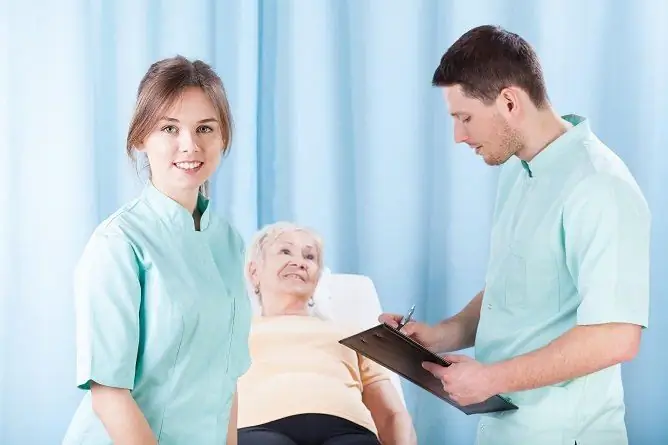- Author Rachel Wainwright [email protected].
- Public 2023-12-15 07:39.
- Last modified 2025-11-02 20:14.
How to register a disability after a stroke
The content of the article:
- Is a stroke a reason to qualify for a disability?
- What is ITU and how does it work
- What documents do you need to have to pass the ITU
-
Disability groups after stroke
- First group of disability
- Second group of disability
- Third group of disability
- Restrictions on employment
- How to get a disability after a stroke for a bedridden patient
- How to get a disability pension
- Appealing an ITU decision in case of refusal
- Video
Disability after a stroke, that is, its documentary confirmation, is a necessity for almost all patients who have undergone it. Stroke is an acute circulatory disorder of the brain, which can affect different parts of the brain and have different consequences. The defeat can become irreversible, and if the blood supply to the areas responsible for cognitive functions or movement is disrupted, the person becomes disabled, needs help and special rights.

Registration of disability after a stroke is required for patients who have lost the ability to work in whole or in part
Is a stroke a reason to qualify for a disability?
In many cases, a stroke is a sufficient reason for disability, since it leads to the development of irreversible disorders of the body's functioning. A person who has survived a hemorrhagic or ischemic stroke requires a long period of rehabilitation, often cannot do without the help of others. The disability group is assigned according to the decision of the expert commission, which assesses the degree of damage, performance and physiological parameters. Since a stroke is a serious pathology that can be accompanied by a dysfunction of many organs and systems, it is necessary to submit documents for passing the MSE (medical and social examination).
What is ITU and how does it work
The medical and social examination is carried out by a commission consisting of doctors of different directions, its purpose is a comprehensive assessment of the parameters of a person applying for disability after a stroke, his physical and cognitive capabilities. The application procedure is as follows:
- After being discharged from the hospital, a district doctor, attending physician or family doctor must fill out a medical history, issue an appropriate referral to narrow specialists, whose conclusions will be needed to pass the commission.
- Full examination. At this stage, the patient receives a consultation from a cardiologist, neurologist, psychiatrist. After that, he is sent for laboratory examination - biochemical and general blood tests (protein markers of brain tissue damage are determined), urine. The final stage is a series of instrumental examinations - X-ray, CT, MRI, ultrasound using the Doppler effect and others.
- Receive referrals directly to ITU.
After that, you can go for examination. It is worth preparing for this also psychologically - you need a certain pressure and confidence in your own position, supported by objective data, because often members of the commission are reluctant to assign a disability group to those patients who have symptoms of damage after a stroke that are not systemic or not pronounced clearly, albeit confirmed by an examination …
What documents do you need to have to pass the ITU
Without a package of documents, the passage of the expert commission is impossible - some of the certificates are issued for a long time, so preparation should be started in advance. List of required documents:
- referral to ITU issued by the attending physician;
- passport and photocopies of pages with identity data and registration;
- a copy of the work book, certified by a notary;
- outpatient card;
- results of all examinations;
- insurance policy (if any).
The doctor should inform about additional documents that will need to be prepared, or you can clarify the list in the information department of the polyclinic.
Disability groups after stroke
When passing ITU, doctors take into account the degree of damage to target organs and systems. During the passage of the commission, the following is assessed:
- violation of mental functions - for this, the patient undergoes a series of cognitive tests for attentiveness, memory, logical thinking. For example, a pathology on the part of the nervous system is the inability to connect numbers in ascending order for a certain time;
- violation of limb mobility - flexion and extension of the limb in the joints, the range of motion, the accuracy of their implementation are checked;
- violation of fine motor skills - dysfunction of the hands and fingers, inability to perform minor manipulations;
- violation of speech - incoherent sentences, confused meanings, fuzzy diction;
- the state of organs and systems - each of those present asks questions within the framework of their qualifications and / or analyzes the data available after inpatient treatment and the survey.
Basically, attention is paid to the patient's sound thinking, the degree of his dependence on others, the ability to self-service and perform basic everyday tasks, the ability to move independently both at home and in public places, and use transport. Attention is also paid to the level of the patient's orientation in space, his awareness of his own position, the adequacy of his communication with others. Usually, there is no separate distribution of patients by age; this parameter is taken into account in the overall comprehensive assessment.
Based on the results obtained, the application can be rejected, sent for reconsideration in an expanded composition of the commission, or approved - in this case, the patient is assigned one of three disability groups.
First group of disability
The affected area touches vital structures, which significantly impairs the patient's standard of living and interferes with his daily tasks. Severe dysfunctions of the musculoskeletal system are observed, the patient cannot lead a full life on his own, he needs a nurse or constant help from a loved one. The patient is incapable of self-care, has an unstable condition and requires constant care.
Second group of disability
The functions of some organs and the musculoskeletal system are impaired, and the ability to work is lost. Such a patient can serve himself independently and does not require constant supervision, but he cannot work, except in cases with special working conditions and a prepared workplace, a shorter working day and other adaptive measures.
Third group of disability
Moderate violation of organs and systems that have a positive trend and prognosis. The working capacity of such patients is preserved to the best of their ability, and with the provision of special working conditions, they are allowed to triple to work and continue working.
Restrictions on employment
The range of possible options for professional employment is sharply narrowed for disabled people, because they are no longer able to perform a large amount of work with high precision. If there is such an opportunity, then there are a number of unfavorable factors that should be taken into account when organizing work for a disabled person after a stroke:
- elimination of heavy physical exertion and activities that increase blood pressure (climbing stairs, driving fast);
- preservation of emotional calmness - the patient cannot be engaged in stressful work that requires constant emotional and mental stress;
- minimization of temperature differences in production - a sharp change in temperature affects blood vessels and blood pressure. This item includes work on the street or with hot ovens, machines;
- exclusion of the impact of industrial hazards - radiation, toxins, dust particles;
- reducing the volume of static load - it is necessary to alternate active work with periods of rest, since a person after a stroke should not overexert themselves.
If these restrictions are observed, the risk of recurrent stroke is significantly reduced.
How to get a disability after a stroke for a bedridden patient
If the patient cannot come to the bureau for examination and passing the ITU on his own or for health reasons, it is possible to carry it out at the place of residence or in a medical institution. To do this, a doctor must come to the patient, who will confirm the need for passing the MSE at home or in a hospital.
It is also possible to carry out an absentee examination in the presence of a complete package of documents and clinical examinations, as well as the written consent of the attending physician.
In fairness, it should be noted that the chances of getting a disability after a stroke in a bedridden patient is higher than in patients with more superficial symptoms.
How to get a disability pension
Pension payments are only possible after the assignment of the degree of disability. To do this, you need to get a certificate from the head of the commission about its passage, as well as an individual rehabilitation program. Registration for the payment of a pension takes place at the Pension Fund, where you should write a statement on the assignment of regular payments.
For additional assistance and sanatorium vouchers, the provision of free medicines, you must register with the social protection authorities.
The size of the pension in Russia is determined by a special formula:
P = PC / (T x K) + B, where
P is the amount of the assigned disability pension;
PC - the estimated pension capital of a citizen who has received a disability;
T - months before the time when the old-age pension should be awarded;
K - the ratio of insurance experience to an indicator equal to 180 months;
B is the base value of the disability pension.
Thus, the maximum pension is assigned to the disabled of the 1st group.
Many patients are interested in whether a pensioner needs to apply for a disability after a stroke? If the medical and social expertise confirms the need for ongoing care, such a patient may be eligible for a monthly compensation payment.
Appealing an ITU decision in case of refusal
If the disability was not assigned during the meeting of the commission, then the decision of the experts can be appealed. To do this, it is necessary, as soon as possible, a maximum of three days from the date of refusal, to write a second letter to the bureau where the examination is underway. Time is important in this case, if the deadline has passed, the patient loses the right to appeal the decision and is recognized as agreeing with the verdict of the commission.
The appeal takes place in higher instances, one of them is the ITU Federal Bureau. If in the work of the bureau staff and doctors there was bias, negligence, and the patient has all the necessary documents and results to obtain disability after a stroke, then the appeal can even take place in court.
The court decision is final and cannot be challenged. Usually, the application re-examination process takes about a month.
Video
We offer for viewing a video on the topic of the article.

Nikita Gaidukov About the author
Education: 4th year student of the Faculty of Medicine No. 1, specializing in General Medicine, Vinnitsa National Medical University. N. I. Pirogov.
Work experience: Nurse of the cardiology department of the Tyachiv Regional Hospital No. 1, geneticist / molecular biologist in the Polymerase Chain Reaction Laboratory at VNMU named after N. I. Pirogov.
Found a mistake in the text? Select it and press Ctrl + Enter.






